Leadership and Effecting Change in Public Health: A Detailed Report
VerifiedAdded on 2021/04/21
|11
|2660
|200
Report
AI Summary
This report delves into the critical role of leadership in public health and its impact on effecting positive change. It differentiates between the roles of leaders and managers, emphasizing the unique contributions of each in the public health sector. The report examines the leadership approaches of prominent figures like Charles Lyons, the President and CEO of the Elizabeth Glaser Pediatric AIDS Foundation, and Michelle Obama, focusing on their strategies and the advantages and disadvantages of their approaches. It also analyzes the results of a leadership skills inventory, comparing them to Rowitz’s Public Health Leadership Principles. The report concludes by highlighting the importance of effective leadership in preserving public health and the need for leaders to adopt appropriate approaches to ensure success.
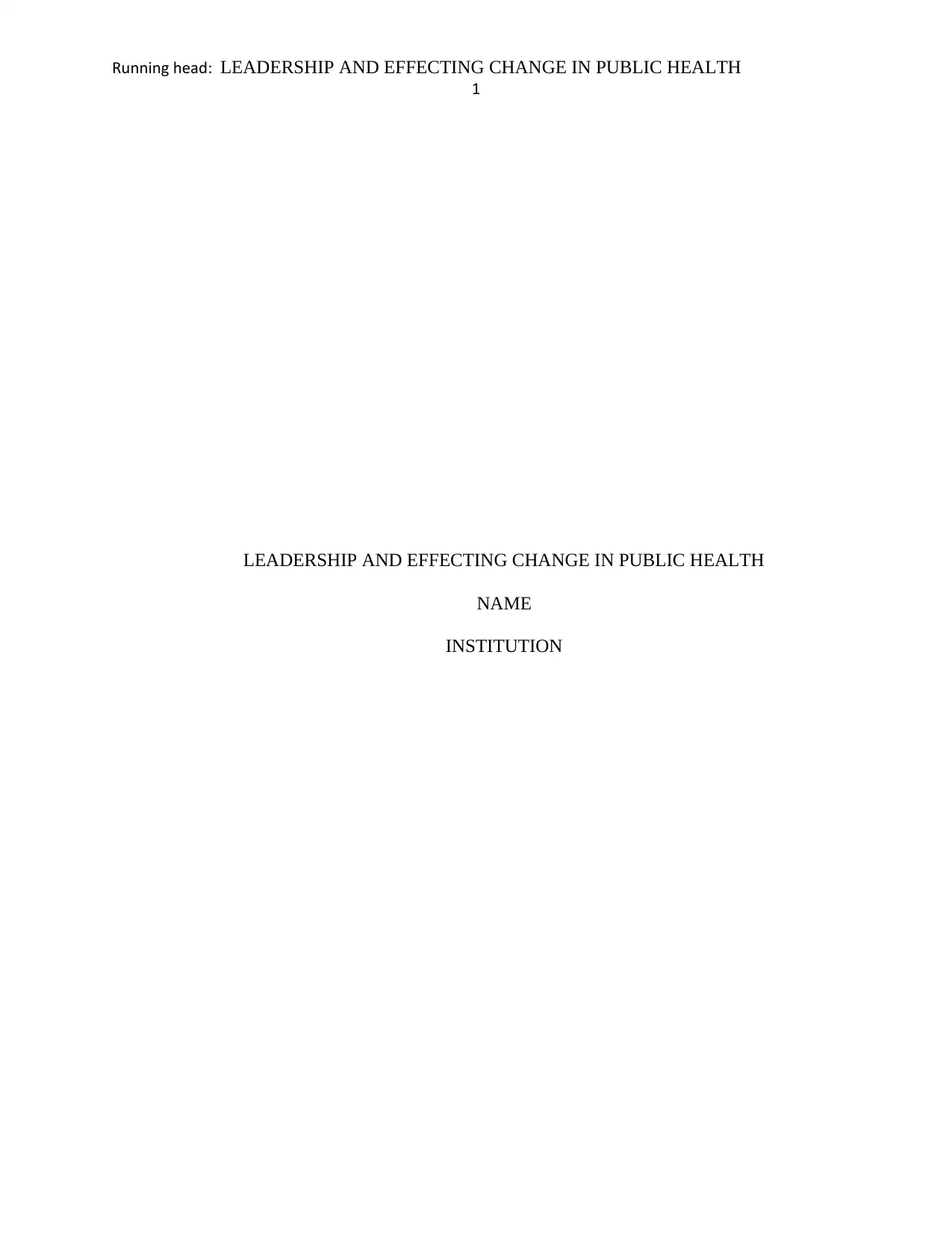
Running head: LEADERSHIP AND EFFECTING CHANGE IN PUBLIC HEALTH
1
LEADERSHIP AND EFFECTING CHANGE IN PUBLIC HEALTH
NAME
INSTITUTION
1
LEADERSHIP AND EFFECTING CHANGE IN PUBLIC HEALTH
NAME
INSTITUTION
Paraphrase This Document
Need a fresh take? Get an instant paraphrase of this document with our AI Paraphraser
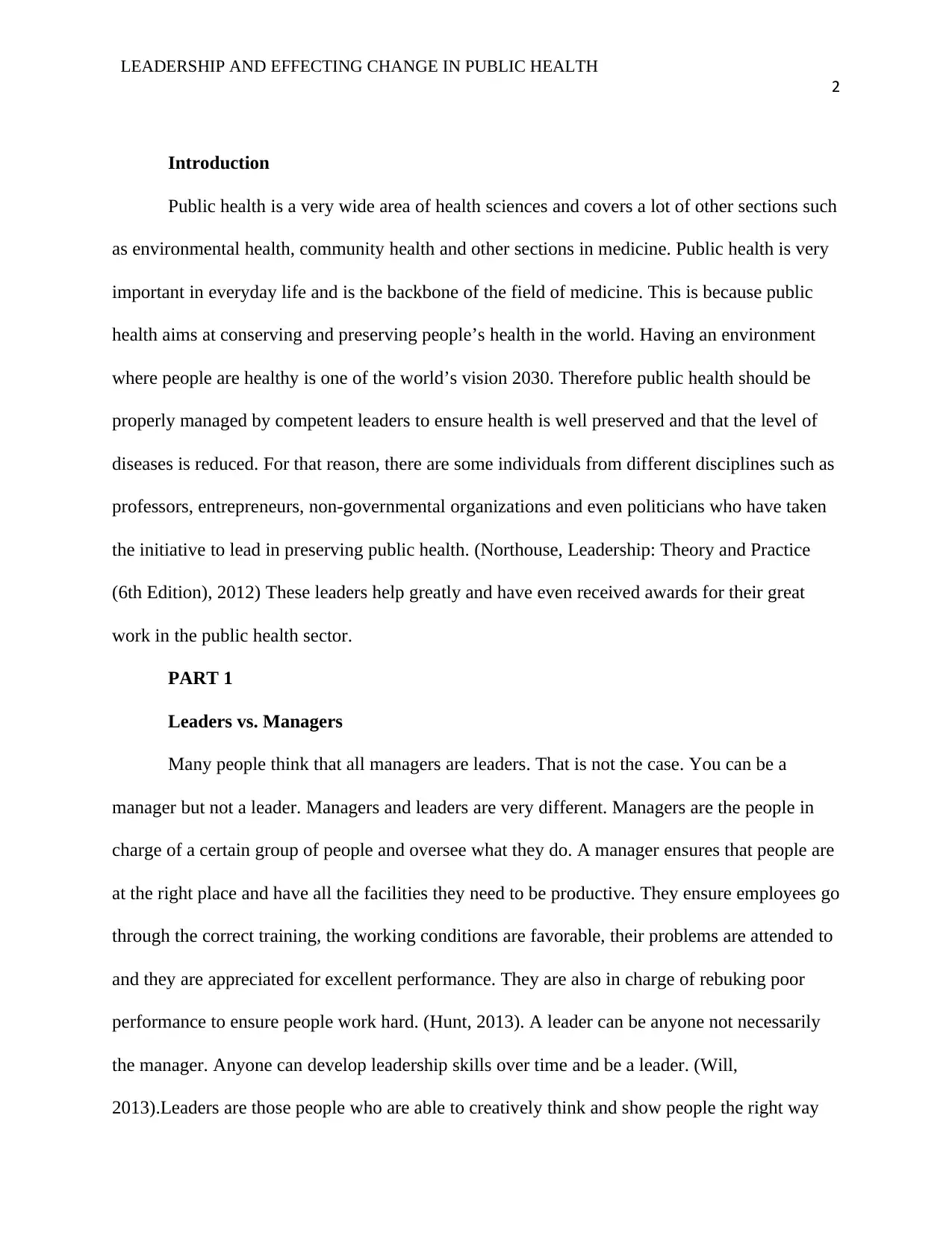
LEADERSHIP AND EFFECTING CHANGE IN PUBLIC HEALTH
2
Introduction
Public health is a very wide area of health sciences and covers a lot of other sections such
as environmental health, community health and other sections in medicine. Public health is very
important in everyday life and is the backbone of the field of medicine. This is because public
health aims at conserving and preserving people’s health in the world. Having an environment
where people are healthy is one of the world’s vision 2030. Therefore public health should be
properly managed by competent leaders to ensure health is well preserved and that the level of
diseases is reduced. For that reason, there are some individuals from different disciplines such as
professors, entrepreneurs, non-governmental organizations and even politicians who have taken
the initiative to lead in preserving public health. (Northouse, Leadership: Theory and Practice
(6th Edition), 2012) These leaders help greatly and have even received awards for their great
work in the public health sector.
PART 1
Leaders vs. Managers
Many people think that all managers are leaders. That is not the case. You can be a
manager but not a leader. Managers and leaders are very different. Managers are the people in
charge of a certain group of people and oversee what they do. A manager ensures that people are
at the right place and have all the facilities they need to be productive. They ensure employees go
through the correct training, the working conditions are favorable, their problems are attended to
and they are appreciated for excellent performance. They are also in charge of rebuking poor
performance to ensure people work hard. (Hunt, 2013). A leader can be anyone not necessarily
the manager. Anyone can develop leadership skills over time and be a leader. (Will,
2013).Leaders are those people who are able to creatively think and show people the right way
2
Introduction
Public health is a very wide area of health sciences and covers a lot of other sections such
as environmental health, community health and other sections in medicine. Public health is very
important in everyday life and is the backbone of the field of medicine. This is because public
health aims at conserving and preserving people’s health in the world. Having an environment
where people are healthy is one of the world’s vision 2030. Therefore public health should be
properly managed by competent leaders to ensure health is well preserved and that the level of
diseases is reduced. For that reason, there are some individuals from different disciplines such as
professors, entrepreneurs, non-governmental organizations and even politicians who have taken
the initiative to lead in preserving public health. (Northouse, Leadership: Theory and Practice
(6th Edition), 2012) These leaders help greatly and have even received awards for their great
work in the public health sector.
PART 1
Leaders vs. Managers
Many people think that all managers are leaders. That is not the case. You can be a
manager but not a leader. Managers and leaders are very different. Managers are the people in
charge of a certain group of people and oversee what they do. A manager ensures that people are
at the right place and have all the facilities they need to be productive. They ensure employees go
through the correct training, the working conditions are favorable, their problems are attended to
and they are appreciated for excellent performance. They are also in charge of rebuking poor
performance to ensure people work hard. (Hunt, 2013). A leader can be anyone not necessarily
the manager. Anyone can develop leadership skills over time and be a leader. (Will,
2013).Leaders are those people who are able to creatively think and show people the right way
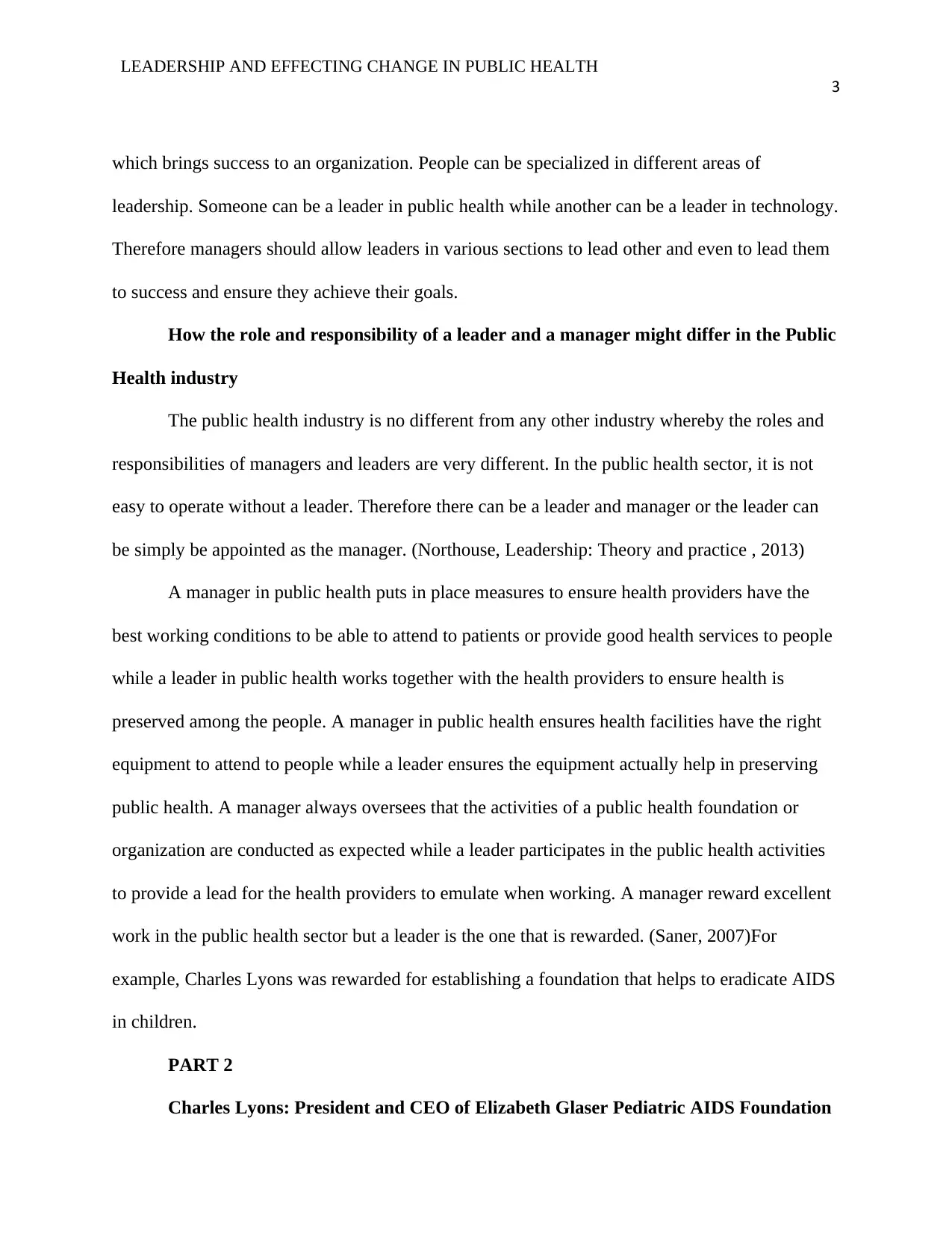
LEADERSHIP AND EFFECTING CHANGE IN PUBLIC HEALTH
3
which brings success to an organization. People can be specialized in different areas of
leadership. Someone can be a leader in public health while another can be a leader in technology.
Therefore managers should allow leaders in various sections to lead other and even to lead them
to success and ensure they achieve their goals.
How the role and responsibility of a leader and a manager might differ in the Public
Health industry
The public health industry is no different from any other industry whereby the roles and
responsibilities of managers and leaders are very different. In the public health sector, it is not
easy to operate without a leader. Therefore there can be a leader and manager or the leader can
be simply be appointed as the manager. (Northouse, Leadership: Theory and practice , 2013)
A manager in public health puts in place measures to ensure health providers have the
best working conditions to be able to attend to patients or provide good health services to people
while a leader in public health works together with the health providers to ensure health is
preserved among the people. A manager in public health ensures health facilities have the right
equipment to attend to people while a leader ensures the equipment actually help in preserving
public health. A manager always oversees that the activities of a public health foundation or
organization are conducted as expected while a leader participates in the public health activities
to provide a lead for the health providers to emulate when working. A manager reward excellent
work in the public health sector but a leader is the one that is rewarded. (Saner, 2007)For
example, Charles Lyons was rewarded for establishing a foundation that helps to eradicate AIDS
in children.
PART 2
Charles Lyons: President and CEO of Elizabeth Glaser Pediatric AIDS Foundation
3
which brings success to an organization. People can be specialized in different areas of
leadership. Someone can be a leader in public health while another can be a leader in technology.
Therefore managers should allow leaders in various sections to lead other and even to lead them
to success and ensure they achieve their goals.
How the role and responsibility of a leader and a manager might differ in the Public
Health industry
The public health industry is no different from any other industry whereby the roles and
responsibilities of managers and leaders are very different. In the public health sector, it is not
easy to operate without a leader. Therefore there can be a leader and manager or the leader can
be simply be appointed as the manager. (Northouse, Leadership: Theory and practice , 2013)
A manager in public health puts in place measures to ensure health providers have the
best working conditions to be able to attend to patients or provide good health services to people
while a leader in public health works together with the health providers to ensure health is
preserved among the people. A manager in public health ensures health facilities have the right
equipment to attend to people while a leader ensures the equipment actually help in preserving
public health. A manager always oversees that the activities of a public health foundation or
organization are conducted as expected while a leader participates in the public health activities
to provide a lead for the health providers to emulate when working. A manager reward excellent
work in the public health sector but a leader is the one that is rewarded. (Saner, 2007)For
example, Charles Lyons was rewarded for establishing a foundation that helps to eradicate AIDS
in children.
PART 2
Charles Lyons: President and CEO of Elizabeth Glaser Pediatric AIDS Foundation
⊘ This is a preview!⊘
Do you want full access?
Subscribe today to unlock all pages.

Trusted by 1+ million students worldwide
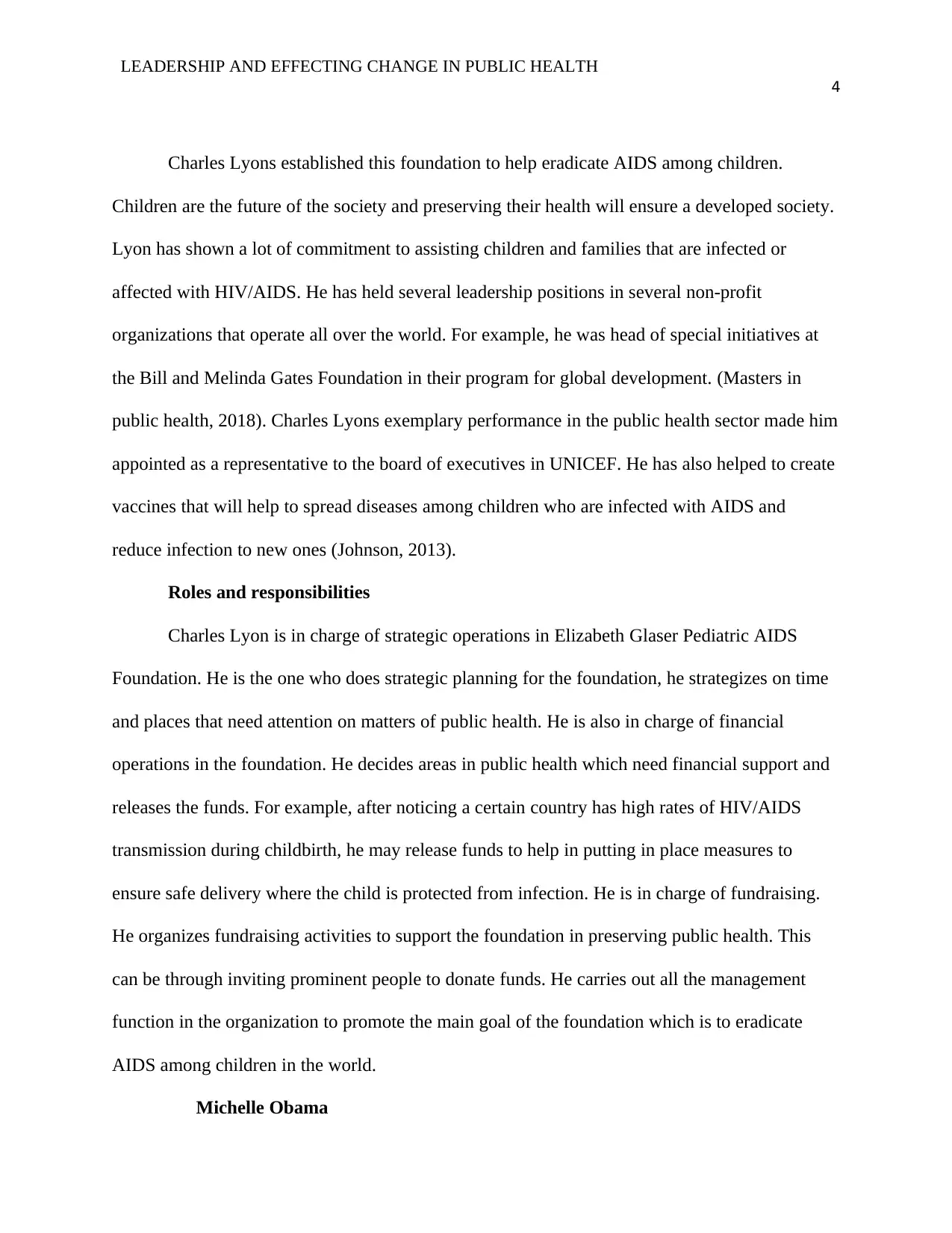
LEADERSHIP AND EFFECTING CHANGE IN PUBLIC HEALTH
4
Charles Lyons established this foundation to help eradicate AIDS among children.
Children are the future of the society and preserving their health will ensure a developed society.
Lyon has shown a lot of commitment to assisting children and families that are infected or
affected with HIV/AIDS. He has held several leadership positions in several non-profit
organizations that operate all over the world. For example, he was head of special initiatives at
the Bill and Melinda Gates Foundation in their program for global development. (Masters in
public health, 2018). Charles Lyons exemplary performance in the public health sector made him
appointed as a representative to the board of executives in UNICEF. He has also helped to create
vaccines that will help to spread diseases among children who are infected with AIDS and
reduce infection to new ones (Johnson, 2013).
Roles and responsibilities
Charles Lyon is in charge of strategic operations in Elizabeth Glaser Pediatric AIDS
Foundation. He is the one who does strategic planning for the foundation, he strategizes on time
and places that need attention on matters of public health. He is also in charge of financial
operations in the foundation. He decides areas in public health which need financial support and
releases the funds. For example, after noticing a certain country has high rates of HIV/AIDS
transmission during childbirth, he may release funds to help in putting in place measures to
ensure safe delivery where the child is protected from infection. He is in charge of fundraising.
He organizes fundraising activities to support the foundation in preserving public health. This
can be through inviting prominent people to donate funds. He carries out all the management
function in the organization to promote the main goal of the foundation which is to eradicate
AIDS among children in the world.
Michelle Obama
4
Charles Lyons established this foundation to help eradicate AIDS among children.
Children are the future of the society and preserving their health will ensure a developed society.
Lyon has shown a lot of commitment to assisting children and families that are infected or
affected with HIV/AIDS. He has held several leadership positions in several non-profit
organizations that operate all over the world. For example, he was head of special initiatives at
the Bill and Melinda Gates Foundation in their program for global development. (Masters in
public health, 2018). Charles Lyons exemplary performance in the public health sector made him
appointed as a representative to the board of executives in UNICEF. He has also helped to create
vaccines that will help to spread diseases among children who are infected with AIDS and
reduce infection to new ones (Johnson, 2013).
Roles and responsibilities
Charles Lyon is in charge of strategic operations in Elizabeth Glaser Pediatric AIDS
Foundation. He is the one who does strategic planning for the foundation, he strategizes on time
and places that need attention on matters of public health. He is also in charge of financial
operations in the foundation. He decides areas in public health which need financial support and
releases the funds. For example, after noticing a certain country has high rates of HIV/AIDS
transmission during childbirth, he may release funds to help in putting in place measures to
ensure safe delivery where the child is protected from infection. He is in charge of fundraising.
He organizes fundraising activities to support the foundation in preserving public health. This
can be through inviting prominent people to donate funds. He carries out all the management
function in the organization to promote the main goal of the foundation which is to eradicate
AIDS among children in the world.
Michelle Obama
Paraphrase This Document
Need a fresh take? Get an instant paraphrase of this document with our AI Paraphraser
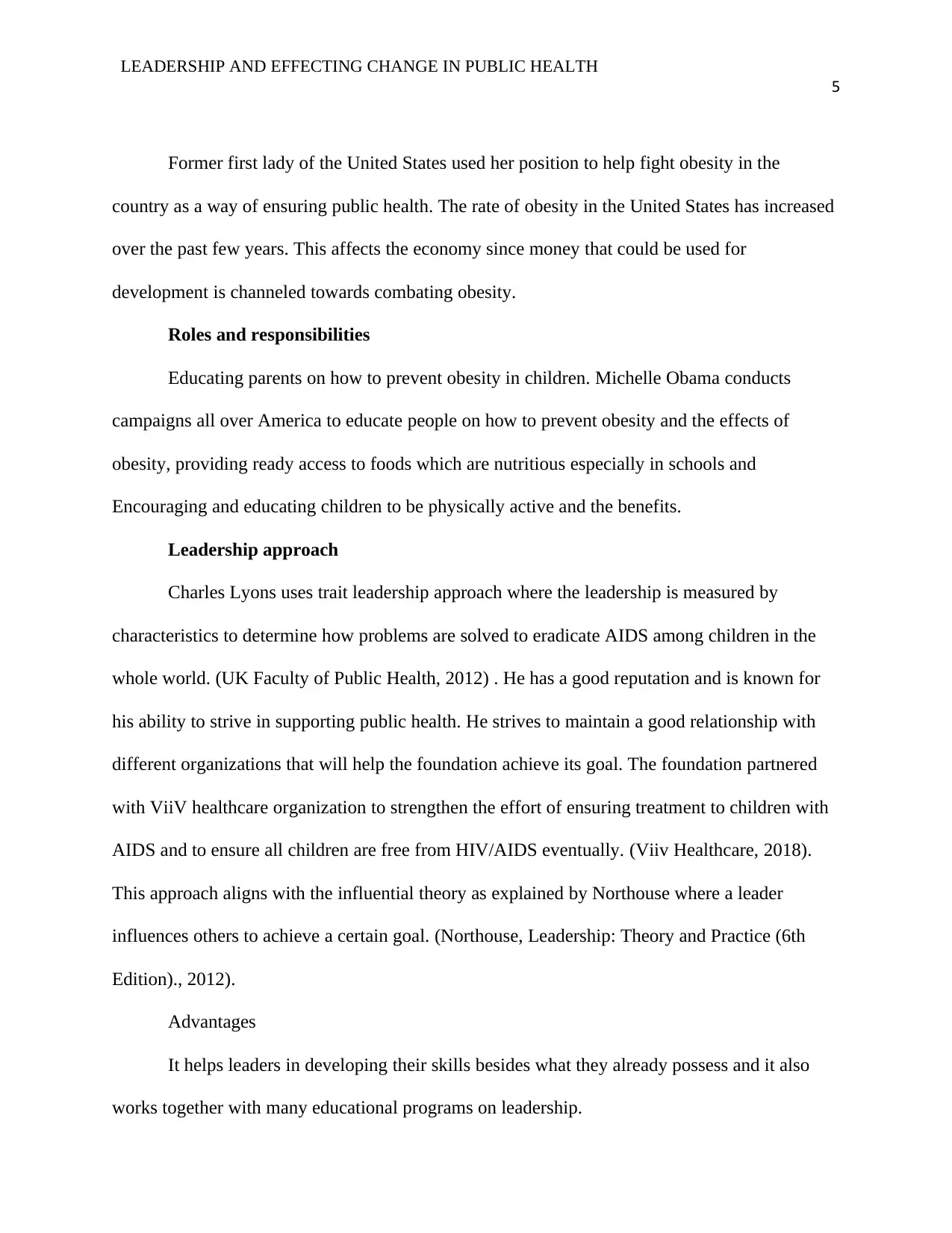
LEADERSHIP AND EFFECTING CHANGE IN PUBLIC HEALTH
5
Former first lady of the United States used her position to help fight obesity in the
country as a way of ensuring public health. The rate of obesity in the United States has increased
over the past few years. This affects the economy since money that could be used for
development is channeled towards combating obesity.
Roles and responsibilities
Educating parents on how to prevent obesity in children. Michelle Obama conducts
campaigns all over America to educate people on how to prevent obesity and the effects of
obesity, providing ready access to foods which are nutritious especially in schools and
Encouraging and educating children to be physically active and the benefits.
Leadership approach
Charles Lyons uses trait leadership approach where the leadership is measured by
characteristics to determine how problems are solved to eradicate AIDS among children in the
whole world. (UK Faculty of Public Health, 2012) . He has a good reputation and is known for
his ability to strive in supporting public health. He strives to maintain a good relationship with
different organizations that will help the foundation achieve its goal. The foundation partnered
with ViiV healthcare organization to strengthen the effort of ensuring treatment to children with
AIDS and to ensure all children are free from HIV/AIDS eventually. (Viiv Healthcare, 2018).
This approach aligns with the influential theory as explained by Northouse where a leader
influences others to achieve a certain goal. (Northouse, Leadership: Theory and Practice (6th
Edition)., 2012).
Advantages
It helps leaders in developing their skills besides what they already possess and it also
works together with many educational programs on leadership.
5
Former first lady of the United States used her position to help fight obesity in the
country as a way of ensuring public health. The rate of obesity in the United States has increased
over the past few years. This affects the economy since money that could be used for
development is channeled towards combating obesity.
Roles and responsibilities
Educating parents on how to prevent obesity in children. Michelle Obama conducts
campaigns all over America to educate people on how to prevent obesity and the effects of
obesity, providing ready access to foods which are nutritious especially in schools and
Encouraging and educating children to be physically active and the benefits.
Leadership approach
Charles Lyons uses trait leadership approach where the leadership is measured by
characteristics to determine how problems are solved to eradicate AIDS among children in the
whole world. (UK Faculty of Public Health, 2012) . He has a good reputation and is known for
his ability to strive in supporting public health. He strives to maintain a good relationship with
different organizations that will help the foundation achieve its goal. The foundation partnered
with ViiV healthcare organization to strengthen the effort of ensuring treatment to children with
AIDS and to ensure all children are free from HIV/AIDS eventually. (Viiv Healthcare, 2018).
This approach aligns with the influential theory as explained by Northouse where a leader
influences others to achieve a certain goal. (Northouse, Leadership: Theory and Practice (6th
Edition)., 2012).
Advantages
It helps leaders in developing their skills besides what they already possess and it also
works together with many educational programs on leadership.
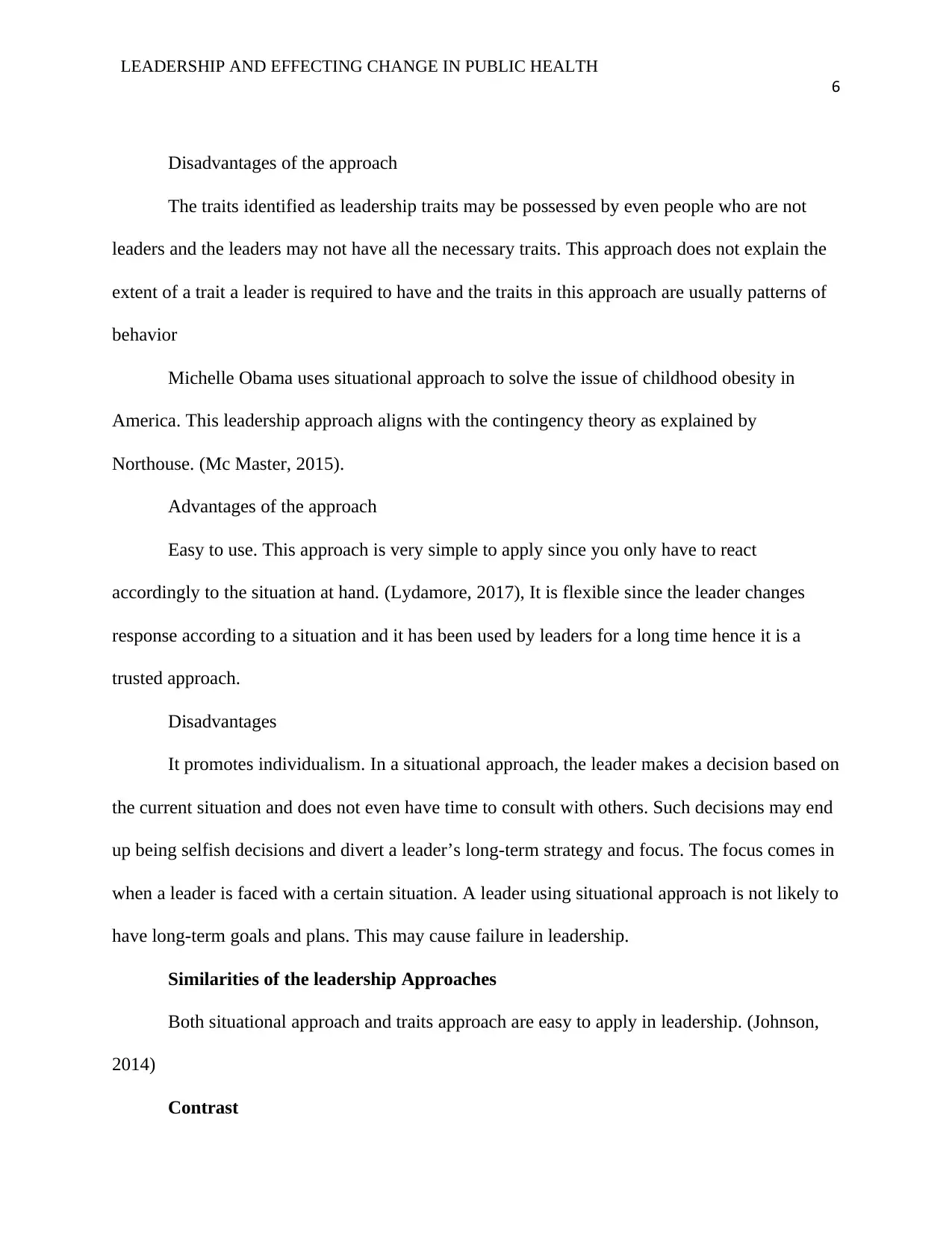
LEADERSHIP AND EFFECTING CHANGE IN PUBLIC HEALTH
6
Disadvantages of the approach
The traits identified as leadership traits may be possessed by even people who are not
leaders and the leaders may not have all the necessary traits. This approach does not explain the
extent of a trait a leader is required to have and the traits in this approach are usually patterns of
behavior
Michelle Obama uses situational approach to solve the issue of childhood obesity in
America. This leadership approach aligns with the contingency theory as explained by
Northouse. (Mc Master, 2015).
Advantages of the approach
Easy to use. This approach is very simple to apply since you only have to react
accordingly to the situation at hand. (Lydamore, 2017), It is flexible since the leader changes
response according to a situation and it has been used by leaders for a long time hence it is a
trusted approach.
Disadvantages
It promotes individualism. In a situational approach, the leader makes a decision based on
the current situation and does not even have time to consult with others. Such decisions may end
up being selfish decisions and divert a leader’s long-term strategy and focus. The focus comes in
when a leader is faced with a certain situation. A leader using situational approach is not likely to
have long-term goals and plans. This may cause failure in leadership.
Similarities of the leadership Approaches
Both situational approach and traits approach are easy to apply in leadership. (Johnson,
2014)
Contrast
6
Disadvantages of the approach
The traits identified as leadership traits may be possessed by even people who are not
leaders and the leaders may not have all the necessary traits. This approach does not explain the
extent of a trait a leader is required to have and the traits in this approach are usually patterns of
behavior
Michelle Obama uses situational approach to solve the issue of childhood obesity in
America. This leadership approach aligns with the contingency theory as explained by
Northouse. (Mc Master, 2015).
Advantages of the approach
Easy to use. This approach is very simple to apply since you only have to react
accordingly to the situation at hand. (Lydamore, 2017), It is flexible since the leader changes
response according to a situation and it has been used by leaders for a long time hence it is a
trusted approach.
Disadvantages
It promotes individualism. In a situational approach, the leader makes a decision based on
the current situation and does not even have time to consult with others. Such decisions may end
up being selfish decisions and divert a leader’s long-term strategy and focus. The focus comes in
when a leader is faced with a certain situation. A leader using situational approach is not likely to
have long-term goals and plans. This may cause failure in leadership.
Similarities of the leadership Approaches
Both situational approach and traits approach are easy to apply in leadership. (Johnson,
2014)
Contrast
⊘ This is a preview!⊘
Do you want full access?
Subscribe today to unlock all pages.

Trusted by 1+ million students worldwide
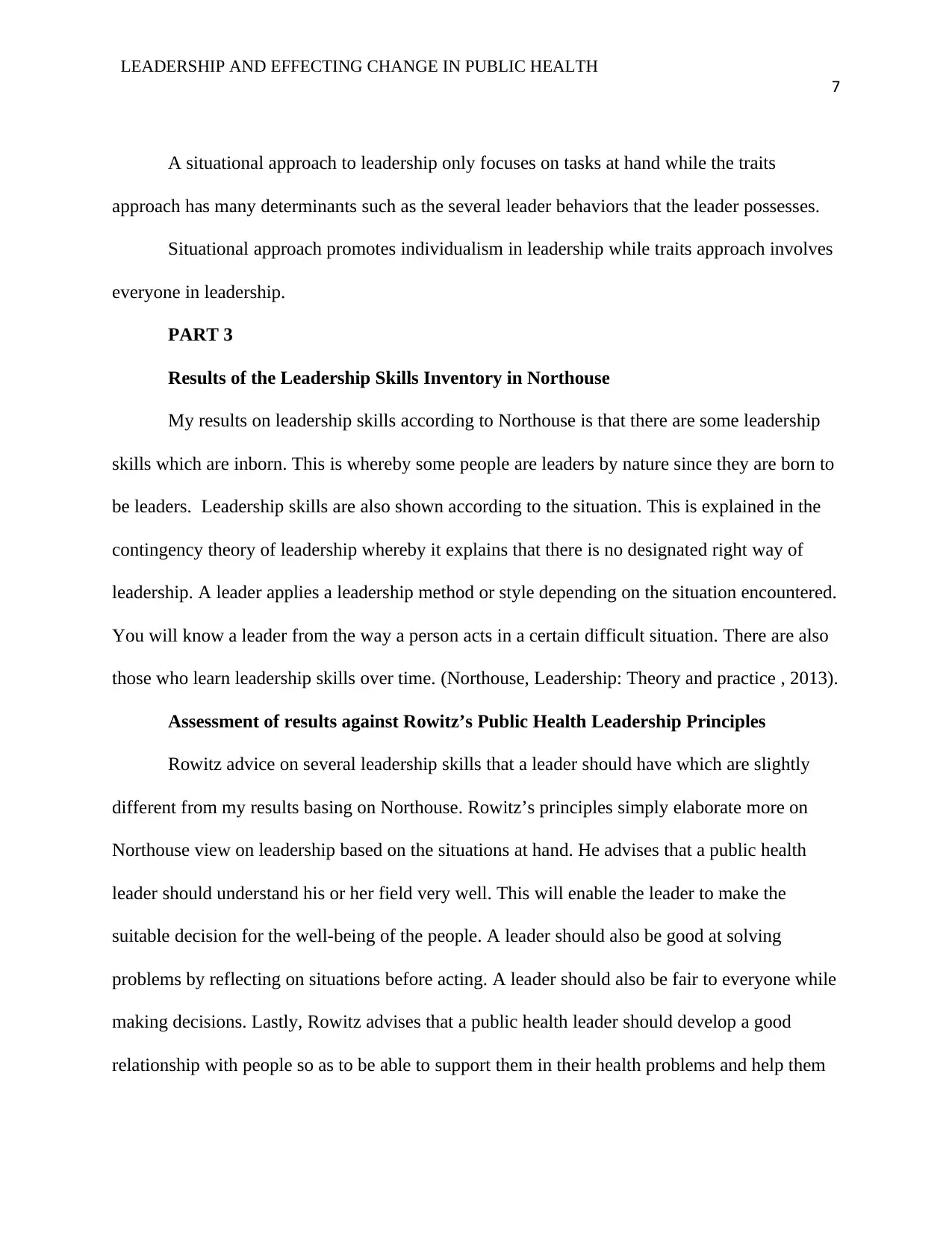
LEADERSHIP AND EFFECTING CHANGE IN PUBLIC HEALTH
7
A situational approach to leadership only focuses on tasks at hand while the traits
approach has many determinants such as the several leader behaviors that the leader possesses.
Situational approach promotes individualism in leadership while traits approach involves
everyone in leadership.
PART 3
Results of the Leadership Skills Inventory in Northouse
My results on leadership skills according to Northouse is that there are some leadership
skills which are inborn. This is whereby some people are leaders by nature since they are born to
be leaders. Leadership skills are also shown according to the situation. This is explained in the
contingency theory of leadership whereby it explains that there is no designated right way of
leadership. A leader applies a leadership method or style depending on the situation encountered.
You will know a leader from the way a person acts in a certain difficult situation. There are also
those who learn leadership skills over time. (Northouse, Leadership: Theory and practice , 2013).
Assessment of results against Rowitz’s Public Health Leadership Principles
Rowitz advice on several leadership skills that a leader should have which are slightly
different from my results basing on Northouse. Rowitz’s principles simply elaborate more on
Northouse view on leadership based on the situations at hand. He advises that a public health
leader should understand his or her field very well. This will enable the leader to make the
suitable decision for the well-being of the people. A leader should also be good at solving
problems by reflecting on situations before acting. A leader should also be fair to everyone while
making decisions. Lastly, Rowitz advises that a public health leader should develop a good
relationship with people so as to be able to support them in their health problems and help them
7
A situational approach to leadership only focuses on tasks at hand while the traits
approach has many determinants such as the several leader behaviors that the leader possesses.
Situational approach promotes individualism in leadership while traits approach involves
everyone in leadership.
PART 3
Results of the Leadership Skills Inventory in Northouse
My results on leadership skills according to Northouse is that there are some leadership
skills which are inborn. This is whereby some people are leaders by nature since they are born to
be leaders. Leadership skills are also shown according to the situation. This is explained in the
contingency theory of leadership whereby it explains that there is no designated right way of
leadership. A leader applies a leadership method or style depending on the situation encountered.
You will know a leader from the way a person acts in a certain difficult situation. There are also
those who learn leadership skills over time. (Northouse, Leadership: Theory and practice , 2013).
Assessment of results against Rowitz’s Public Health Leadership Principles
Rowitz advice on several leadership skills that a leader should have which are slightly
different from my results basing on Northouse. Rowitz’s principles simply elaborate more on
Northouse view on leadership based on the situations at hand. He advises that a public health
leader should understand his or her field very well. This will enable the leader to make the
suitable decision for the well-being of the people. A leader should also be good at solving
problems by reflecting on situations before acting. A leader should also be fair to everyone while
making decisions. Lastly, Rowitz advises that a public health leader should develop a good
relationship with people so as to be able to support them in their health problems and help them
Paraphrase This Document
Need a fresh take? Get an instant paraphrase of this document with our AI Paraphraser
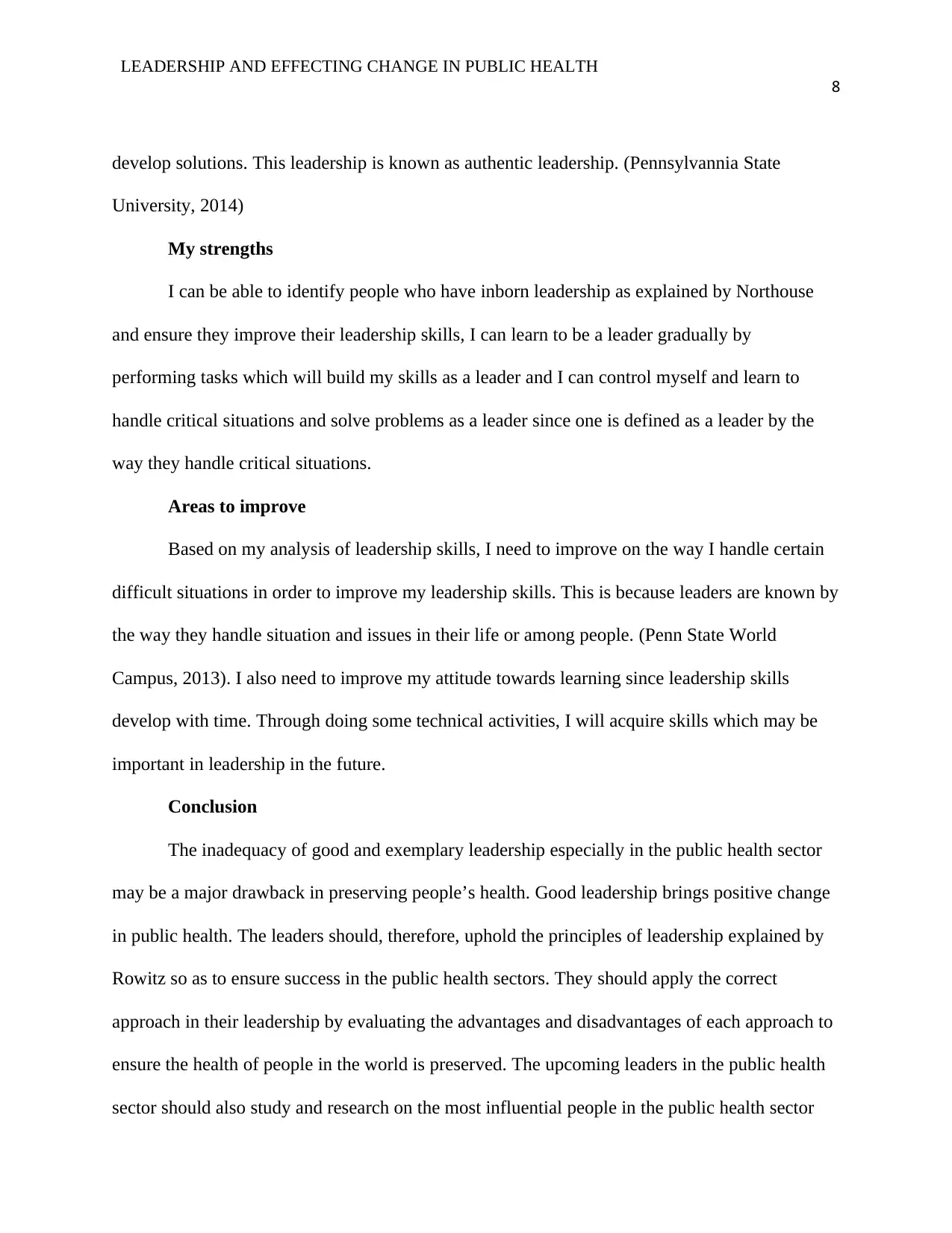
LEADERSHIP AND EFFECTING CHANGE IN PUBLIC HEALTH
8
develop solutions. This leadership is known as authentic leadership. (Pennsylvannia State
University, 2014)
My strengths
I can be able to identify people who have inborn leadership as explained by Northouse
and ensure they improve their leadership skills, I can learn to be a leader gradually by
performing tasks which will build my skills as a leader and I can control myself and learn to
handle critical situations and solve problems as a leader since one is defined as a leader by the
way they handle critical situations.
Areas to improve
Based on my analysis of leadership skills, I need to improve on the way I handle certain
difficult situations in order to improve my leadership skills. This is because leaders are known by
the way they handle situation and issues in their life or among people. (Penn State World
Campus, 2013). I also need to improve my attitude towards learning since leadership skills
develop with time. Through doing some technical activities, I will acquire skills which may be
important in leadership in the future.
Conclusion
The inadequacy of good and exemplary leadership especially in the public health sector
may be a major drawback in preserving people’s health. Good leadership brings positive change
in public health. The leaders should, therefore, uphold the principles of leadership explained by
Rowitz so as to ensure success in the public health sectors. They should apply the correct
approach in their leadership by evaluating the advantages and disadvantages of each approach to
ensure the health of people in the world is preserved. The upcoming leaders in the public health
sector should also study and research on the most influential people in the public health sector
8
develop solutions. This leadership is known as authentic leadership. (Pennsylvannia State
University, 2014)
My strengths
I can be able to identify people who have inborn leadership as explained by Northouse
and ensure they improve their leadership skills, I can learn to be a leader gradually by
performing tasks which will build my skills as a leader and I can control myself and learn to
handle critical situations and solve problems as a leader since one is defined as a leader by the
way they handle critical situations.
Areas to improve
Based on my analysis of leadership skills, I need to improve on the way I handle certain
difficult situations in order to improve my leadership skills. This is because leaders are known by
the way they handle situation and issues in their life or among people. (Penn State World
Campus, 2013). I also need to improve my attitude towards learning since leadership skills
develop with time. Through doing some technical activities, I will acquire skills which may be
important in leadership in the future.
Conclusion
The inadequacy of good and exemplary leadership especially in the public health sector
may be a major drawback in preserving people’s health. Good leadership brings positive change
in public health. The leaders should, therefore, uphold the principles of leadership explained by
Rowitz so as to ensure success in the public health sectors. They should apply the correct
approach in their leadership by evaluating the advantages and disadvantages of each approach to
ensure the health of people in the world is preserved. The upcoming leaders in the public health
sector should also study and research on the most influential people in the public health sector
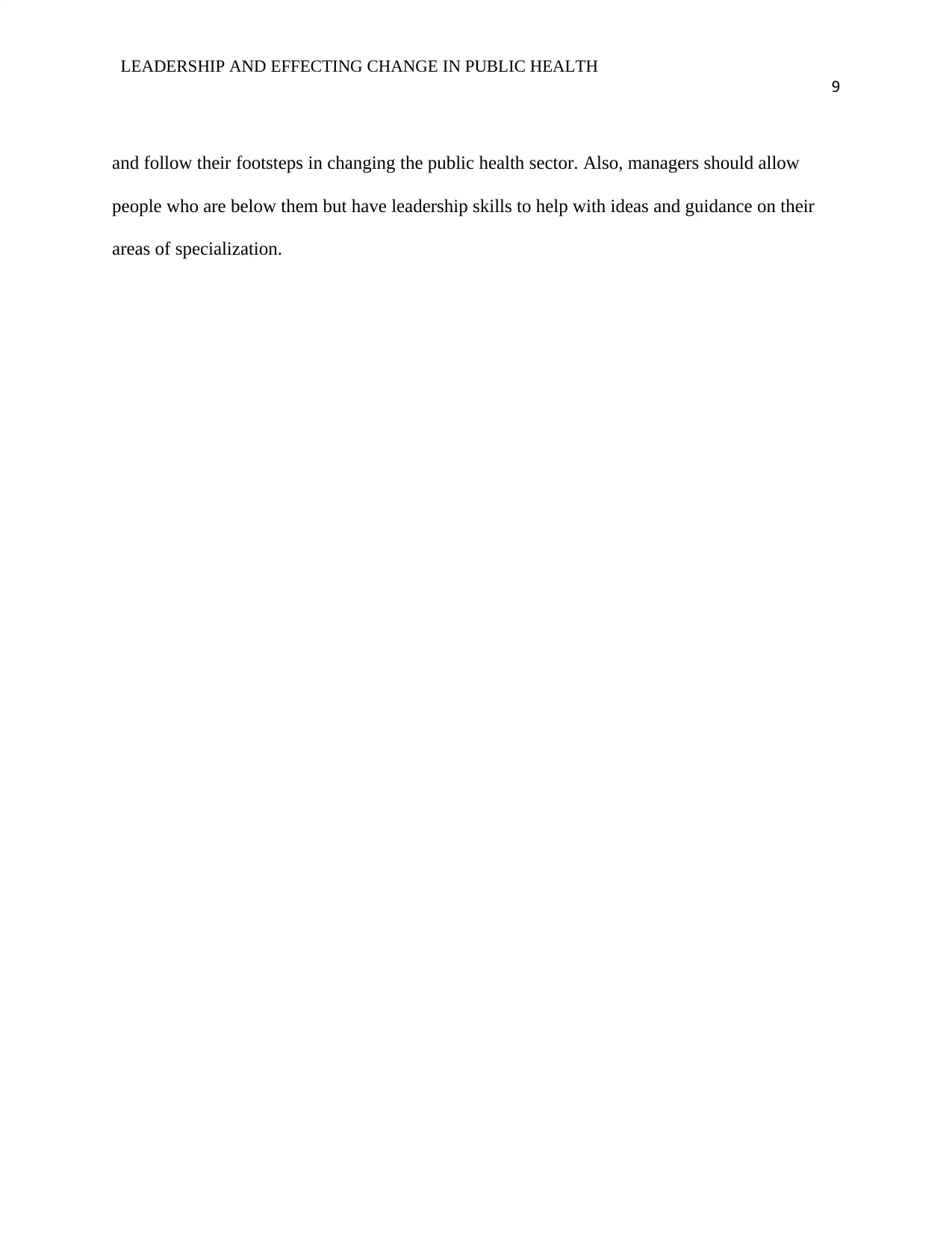
LEADERSHIP AND EFFECTING CHANGE IN PUBLIC HEALTH
9
and follow their footsteps in changing the public health sector. Also, managers should allow
people who are below them but have leadership skills to help with ideas and guidance on their
areas of specialization.
9
and follow their footsteps in changing the public health sector. Also, managers should allow
people who are below them but have leadership skills to help with ideas and guidance on their
areas of specialization.
⊘ This is a preview!⊘
Do you want full access?
Subscribe today to unlock all pages.

Trusted by 1+ million students worldwide
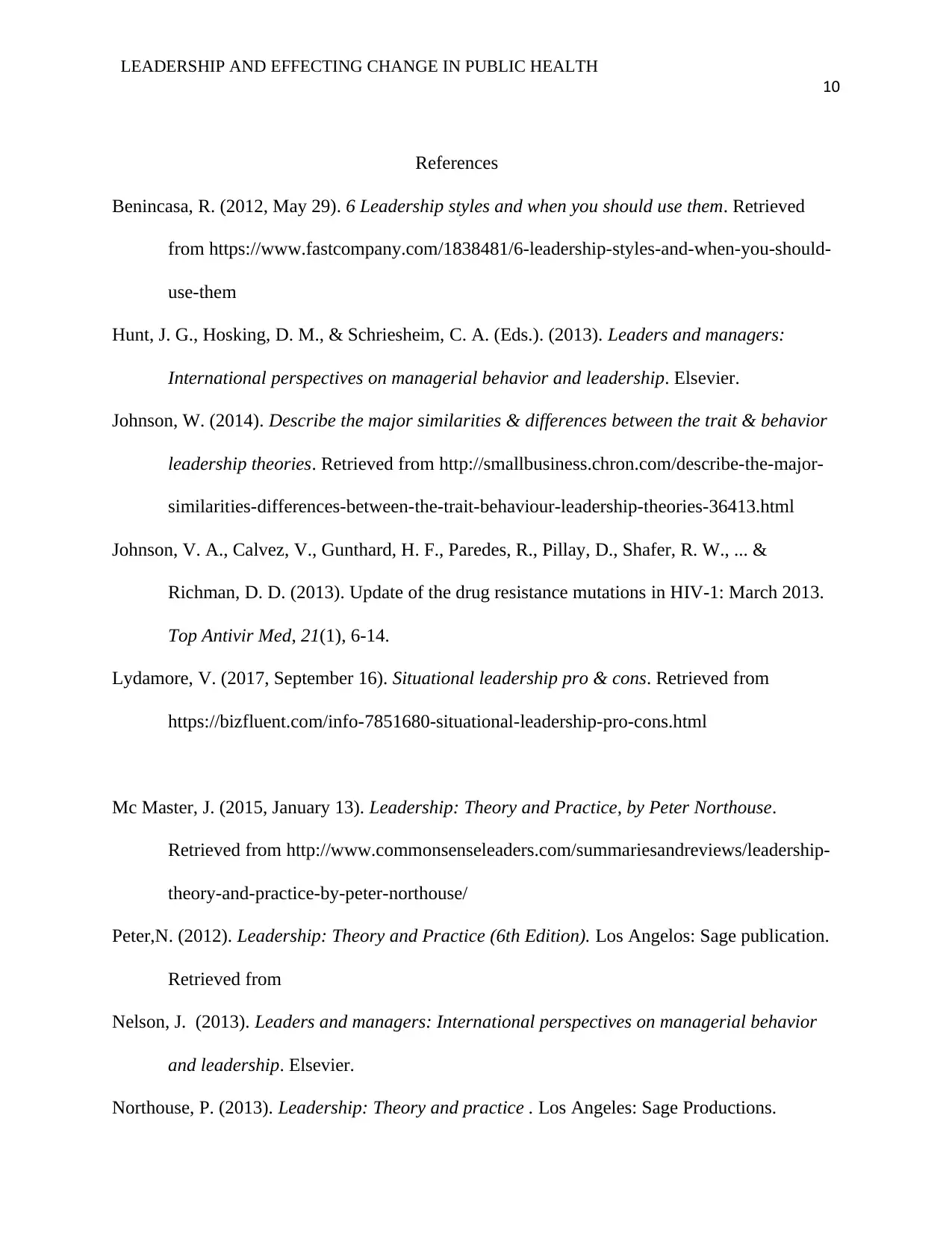
LEADERSHIP AND EFFECTING CHANGE IN PUBLIC HEALTH
10
References
Benincasa, R. (2012, May 29). 6 Leadership styles and when you should use them. Retrieved
from https://www.fastcompany.com/1838481/6-leadership-styles-and-when-you-should-
use-them
Hunt, J. G., Hosking, D. M., & Schriesheim, C. A. (Eds.). (2013). Leaders and managers:
International perspectives on managerial behavior and leadership. Elsevier.
Johnson, W. (2014). Describe the major similarities & differences between the trait & behavior
leadership theories. Retrieved from http://smallbusiness.chron.com/describe-the-major-
similarities-differences-between-the-trait-behaviour-leadership-theories-36413.html
Johnson, V. A., Calvez, V., Gunthard, H. F., Paredes, R., Pillay, D., Shafer, R. W., ... &
Richman, D. D. (2013). Update of the drug resistance mutations in HIV-1: March 2013.
Top Antivir Med, 21(1), 6-14.
Lydamore, V. (2017, September 16). Situational leadership pro & cons. Retrieved from
https://bizfluent.com/info-7851680-situational-leadership-pro-cons.html
Mc Master, J. (2015, January 13). Leadership: Theory and Practice, by Peter Northouse.
Retrieved from http://www.commonsenseleaders.com/summariesandreviews/leadership-
theory-and-practice-by-peter-northouse/
Peter,N. (2012). Leadership: Theory and Practice (6th Edition). Los Angelos: Sage publication.
Retrieved from
Nelson, J. (2013). Leaders and managers: International perspectives on managerial behavior
and leadership. Elsevier.
Northouse, P. (2013). Leadership: Theory and practice . Los Angeles: Sage Productions.
10
References
Benincasa, R. (2012, May 29). 6 Leadership styles and when you should use them. Retrieved
from https://www.fastcompany.com/1838481/6-leadership-styles-and-when-you-should-
use-them
Hunt, J. G., Hosking, D. M., & Schriesheim, C. A. (Eds.). (2013). Leaders and managers:
International perspectives on managerial behavior and leadership. Elsevier.
Johnson, W. (2014). Describe the major similarities & differences between the trait & behavior
leadership theories. Retrieved from http://smallbusiness.chron.com/describe-the-major-
similarities-differences-between-the-trait-behaviour-leadership-theories-36413.html
Johnson, V. A., Calvez, V., Gunthard, H. F., Paredes, R., Pillay, D., Shafer, R. W., ... &
Richman, D. D. (2013). Update of the drug resistance mutations in HIV-1: March 2013.
Top Antivir Med, 21(1), 6-14.
Lydamore, V. (2017, September 16). Situational leadership pro & cons. Retrieved from
https://bizfluent.com/info-7851680-situational-leadership-pro-cons.html
Mc Master, J. (2015, January 13). Leadership: Theory and Practice, by Peter Northouse.
Retrieved from http://www.commonsenseleaders.com/summariesandreviews/leadership-
theory-and-practice-by-peter-northouse/
Peter,N. (2012). Leadership: Theory and Practice (6th Edition). Los Angelos: Sage publication.
Retrieved from
Nelson, J. (2013). Leaders and managers: International perspectives on managerial behavior
and leadership. Elsevier.
Northouse, P. (2013). Leadership: Theory and practice . Los Angeles: Sage Productions.
Paraphrase This Document
Need a fresh take? Get an instant paraphrase of this document with our AI Paraphraser
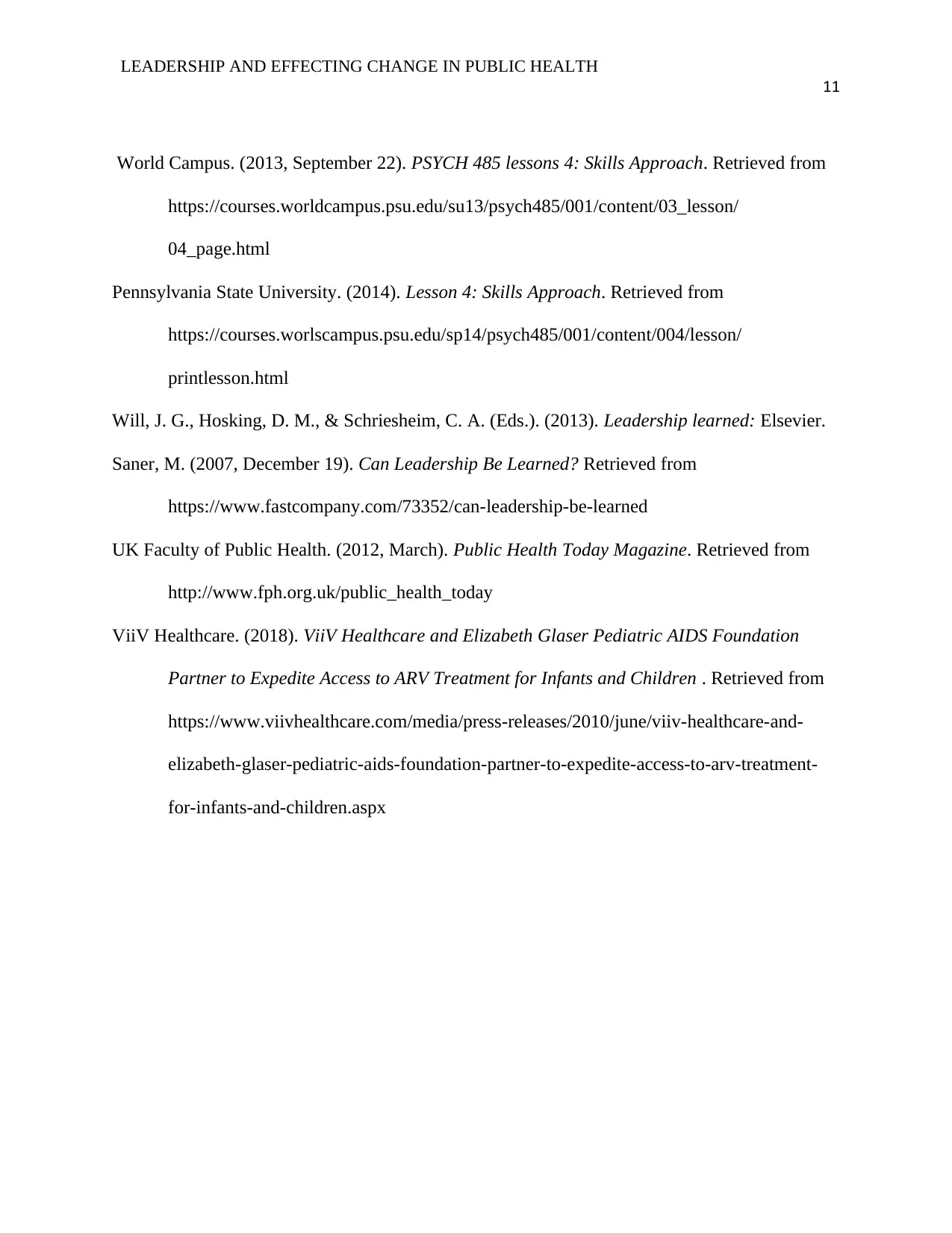
LEADERSHIP AND EFFECTING CHANGE IN PUBLIC HEALTH
11
World Campus. (2013, September 22). PSYCH 485 lessons 4: Skills Approach. Retrieved from
https://courses.worldcampus.psu.edu/su13/psych485/001/content/03_lesson/
04_page.html
Pennsylvania State University. (2014). Lesson 4: Skills Approach. Retrieved from
https://courses.worlscampus.psu.edu/sp14/psych485/001/content/004/lesson/
printlesson.html
Will, J. G., Hosking, D. M., & Schriesheim, C. A. (Eds.). (2013). Leadership learned: Elsevier.
Saner, M. (2007, December 19). Can Leadership Be Learned? Retrieved from
https://www.fastcompany.com/73352/can-leadership-be-learned
UK Faculty of Public Health. (2012, March). Public Health Today Magazine. Retrieved from
http://www.fph.org.uk/public_health_today
ViiV Healthcare. (2018). ViiV Healthcare and Elizabeth Glaser Pediatric AIDS Foundation
Partner to Expedite Access to ARV Treatment for Infants and Children . Retrieved from
https://www.viivhealthcare.com/media/press-releases/2010/june/viiv-healthcare-and-
elizabeth-glaser-pediatric-aids-foundation-partner-to-expedite-access-to-arv-treatment-
for-infants-and-children.aspx
11
World Campus. (2013, September 22). PSYCH 485 lessons 4: Skills Approach. Retrieved from
https://courses.worldcampus.psu.edu/su13/psych485/001/content/03_lesson/
04_page.html
Pennsylvania State University. (2014). Lesson 4: Skills Approach. Retrieved from
https://courses.worlscampus.psu.edu/sp14/psych485/001/content/004/lesson/
printlesson.html
Will, J. G., Hosking, D. M., & Schriesheim, C. A. (Eds.). (2013). Leadership learned: Elsevier.
Saner, M. (2007, December 19). Can Leadership Be Learned? Retrieved from
https://www.fastcompany.com/73352/can-leadership-be-learned
UK Faculty of Public Health. (2012, March). Public Health Today Magazine. Retrieved from
http://www.fph.org.uk/public_health_today
ViiV Healthcare. (2018). ViiV Healthcare and Elizabeth Glaser Pediatric AIDS Foundation
Partner to Expedite Access to ARV Treatment for Infants and Children . Retrieved from
https://www.viivhealthcare.com/media/press-releases/2010/june/viiv-healthcare-and-
elizabeth-glaser-pediatric-aids-foundation-partner-to-expedite-access-to-arv-treatment-
for-infants-and-children.aspx
1 out of 11
Related Documents
Your All-in-One AI-Powered Toolkit for Academic Success.
+13062052269
info@desklib.com
Available 24*7 on WhatsApp / Email
![[object Object]](/_next/static/media/star-bottom.7253800d.svg)
Unlock your academic potential
Copyright © 2020–2025 A2Z Services. All Rights Reserved. Developed and managed by ZUCOL.





